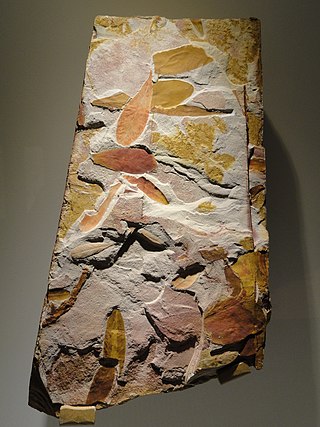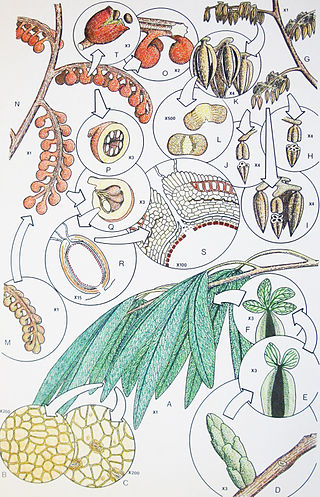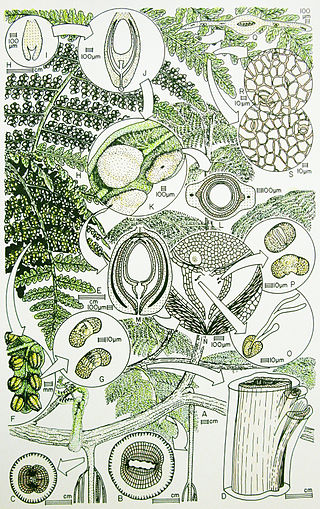
A gonad, sex gland, or reproductive gland is a mixed gland that produces the gametes and sex hormones of an organism. Female reproductive cells are egg cells, and male reproductive cells are sperm. The male gonad, the testicle, produces sperm in the form of spermatozoa. The female gonad, the ovary, produces egg cells. Both of these gametes are haploid cells. Some hermaphroditic animals have a type of gonad called an ovotestis.

Glossopteris is the largest and best-known genus of the extinct Permian order of seed plants known as Glossopteridales. The genus Glossopteris refers only to leaves, within a framework of form genera used in paleobotany. Species of Glossopteris were the dominant trees of the middle to high-latitude lowland vegetation across the supercontinent Gondwana during the Permian Period. Glossopteris fossils were critical in recognizing former connections between the various fragments of Gondwana: South America, Africa, India, Australia, New Zealand, and Antarctica.

Bennettitales is an extinct order of seed plants that first appeared in the Permian period and became extinct in most areas toward the end of the Cretaceous. Bennettitales were amongst the most common seed plants of the Mesozoic, and had morphologies including shrub and cycad-like forms. The foliage of bennettitaleans is superficially nearly indistinguishable from that of cycads, but they are distinguished from cycads by their more complex flower-like reproductive organs, at least some of which were likely pollinated by insects.

Glossopteridales is an extinct order of seed plants, known from the Permian of Gondwana. They arose at the beginning of the Permian, and the majority or all members of the group became extinct at the end of the Permian, during the Permian-Triassic extinction event. Possible Triassic records of the group have been recorded. The best known genus is Glossopteris, a leaf form genus. Other examples are Gangamopteris,Glossotheca, and Vertebraria.

Claudiosaurus is an extinct genus of diapsid reptiles from the Late Permian Sakamena Formation of the Morondava Basin, Madagascar. It has been suggested to be semi-aquatic.

The glossophytes are a clade of seed plants comprising the glossopterids and their descendants. This includes the Gnetales and angiosperms, as well as Bennettitales.

The Caytoniales are an extinct order of seed plants known from fossils collected throughout the Mesozoic Era, around 252 to 66 million years ago. They are regarded as seed ferns because they are seed-bearing plants with fern-like leaves. Although at one time considered angiosperms because of their berry-like cupules, that hypothesis was later disproven. Nevertheless, some authorities consider them likely ancestors or close relatives of angiosperms. The origin of angiosperms remains unclear, and they cannot be linked with any known seed plants groups with certainty.

Caytonia is an extinct genus of seed ferns.

Sagenopteris is a genus of extinct seed ferns from the Triassic to late Early Cretaceous.

Dicroidium is an extinct genus of fork-leaved seed plants. It is the archetypal genus of the corystosperms, an extinct group of seed plants, often called "seed ferns", assigned to the order Corystospermales or Umkomasiales. Species of Dicroidium were widely distributed and dominant over Gondwana during the Triassic. Their fossils are known from South Africa, the Arabian Peninsula, Australia, New Zealand, South America, Madagascar, the Indian subcontinent and Antarctica.

Callistophytales is an extinct order of spermatophytes which lived from the Pennsylvanian to Permian periods. They were mainly scrambling and lianescent (vine-like) plants found in the wetland "coal swamps" of Euramerica and Cathaysia. Like many other early spermatophytes, they could be described as "seed ferns", combining ovule-based reproduction with pinnate leaves superficially similar to modern ferns.

Lepidopteris is a form genus for leaves of Peltaspermaceae, an extinct family of seed plants, which lived from around 260 to 190 million years ago, from the Late Permian to Early Jurassic. Fossils of the genus have been found across both hemispheres. Nine species are currently recognized.Lepidopteris was a common and widespread seed fern, which survived the Permian-Triassic extinction event but was largely wiped out by the Triassic-Jurassic extinction event. Lepidopteris callipteroides is especially common between the first two episodes of Permian-Triassic extinction event, and L. ottonis forms a comparable acme zone immediate before the Triassic-Jurassic extinction event. Lepidopteris would persist into the Early Jurassic in Patagonia, represented by the species Lepidopteris scassoi.

The Peltaspermales are an extinct order of seed plants, often considered "seed ferns". They span from the Late Carboniferous to the Early Jurassic. It includes at least one valid family, Peltaspermaceae, which spans from the Permian to Early Jurassic, which is typified by a group of plants with Lepidopteris leaves, Antevsia pollen-organs, and Peltaspermum ovulate organs, though the family now also includes other genera like Peltaspermopsis, Meyenopteris and Scytophyllum. Along with these, two informal groups of uncertain taxonomic affinities exist, each centered around a specific genus ; Supaia and Comia, known from the Early Permian of the Northern Hemisphere, especially of North America. Both the "Comioids" and the "Supaioids" are associated with the peltaspermacean ovulate organ Autunia. The Late Triassic-Middle Jurassic genus Pachydermophyllum may also have affinities to the peltasperms.

Umkomasia is a genus of seed bearing organs produced by corystosperm seed ferns, first based on fossils collected by Hamshaw Thomas from the Burnera Waterfall locality near the Umkomaas River of South Africa. He recognized on the basis of cuticular similarities that the same plant produced pollen organs Pteruchus and the leaves Dicroidium. Various other corystosperm seed bearing organs from the Jurassic and Cretaceous have been assigned to this genus, but recently have been given distinct genera, with Umkomasia being restricted to the Triassic.

Umkomasia macleanii is an ovulate structure of a seed fern (Pteridospermatophyta and the nominate genus of Family Umkomasiaceae. It was first described by Hamshaw Thomas from the Umkomaas locality of South Africa.

Pteruchus africanus is a pollen organ of a seed fern (Pteridospermatophyta). It was first described by Hamshaw Thomas from the Umkomaas locality of South Africa.

Pteruchus is a form genus for pollen organs of the seed fern (Pteridospermatophyta family Umkomasiaceae. It was first described by Hamshaw Thomas from the Umkomaas locality of South Africa. It is associated with the seed bearing organs Umkomasia and Dicroidium leaves.

Corystosperms are a group of extinct seed plants belonging to the family Corystospermaceae assigned to the order Corystospermales or Umkomasiales. They were first described based on fossils collected by Hamshaw Thomas from the Burnera Waterfall locality near the Umkomaas River of South Africa. Corystosperms are typified by a group of plants that bore forked Dicroidium leaves, Umkomasia cupulate ovulate structures and Pteruchus pollen organs, which grew as trees that were widespread over Gondwana during the Middle and Late Triassic. Other fossil Mesozoic seed plants with similar leaf and/or reproductive structures have also sometimes been included within the "corystosperm" concept sensu lato, such as the "doyleoids" from the Early Cretaceous of North America and Asia. A potential corystosperm sensu lato, the leaf genus Komlopteris, is known from the Eocene of Tasmania, around 53-50 million years old, over 10 million years after the Cretaceous–Paleogene extinction event.

Dictyopteridium is an extinct genus of plants belonging to Glossopteridaceae, but the name is used only for compression fossils of elongate multiovulate reproductive structures adnate to Glossopteris leaves. Permineralized remains identical to Dictyopteridium have been referred to the organ genus Homevaleia
Eugonophyllum is a genus of green algae in the family Halimedaceae. Specimens have been found in Carboniferous to Permian beds in North America, Europe, and east Asia.

















